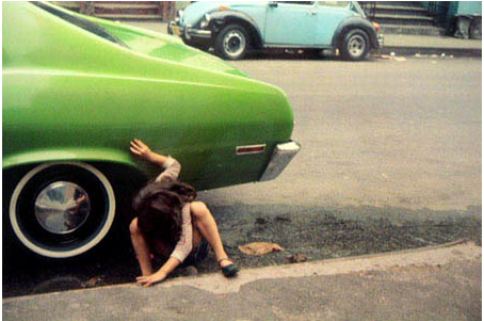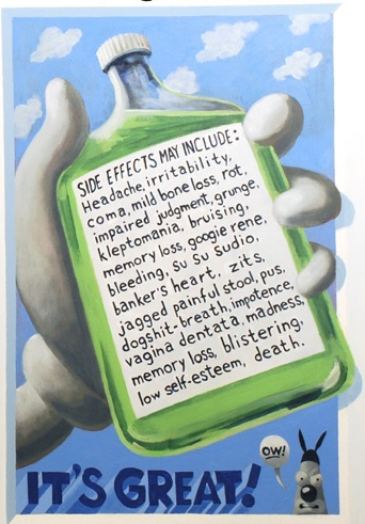
Archives for 2010
Jennie C. Jones – song containers
A container is not the thing contained. It’s a prop instead of an essential, except in the work of Brooklyn’s Jennie C. Jones.
Jones:
My practice is both a comment on and a continuum of the conceptual ideology of jazz, an honoring of the deep radical legacy of its experimentation, of hybrid modernist forms, of wit, of riff — the turning of a phrase onto itself.
Her sculptures and drawings are improvisations on the cassette tape, transistor radio, boom box, Walkman, from intimate long play to the impersonal present. In her hands, old style records with their pop and fizz beat the immaculate conception of new style downloads. You can’t hold a download in your hands. Downloads move from computer to ear bud without taking your body into account, your care or disregard, how you treat your cultural legacy.
Formally, her work is subtle, with a wit that does not translate online. There, her work becomes one thing. In person, it’s myriad-minded.
Top 100 jazz Lps 1969-79, (2010)
Paper, cassette cases, plywood, album list presented as title card.
18 x 24 x 3 in.
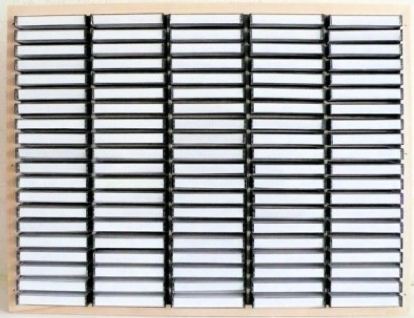 Top 100 jazz Lp’s 1969-79
Top 100 jazz Lp’s 1969-79
has a one-two punch. First, it’s a primary structure – Donald Judd-like with a backbeat of the domestic. A second look delivers the literal. It’s a homage to cassette tapes, a mimicking of their form for abstract effect. Online, the piece looks like a photo of an industrial kind of window shutter.
Holland Cotter called Jones’ installation, Homage to an Unknown Suburban Black Girl, one of the highlights of Freestyle at the Studio Museum in Harlem in 2001.
Cotter:
Based on a found snapshot of a young black girl sitting in what looks like a suburban interior, the piece focused on how two different strands of African-American history coexist in a single picture.
One history is of assimilation, implied by the middle-class setting. The other, suggested by the girl’s Afro hairstyle, is of Black Power politics, which arose in response to a racism that integration alone could not change. In short, in Ms. Jones’s reading, the photograph was a document of people who remained, consciously or not, tolerated guests in the house — American culture — that they had helped to build.
In the same review, he described Jones’ sculptural foray into Bebop at Artists Space as “even subtler.”
Cotter:
This time the document she presents is aural: the sound of Charlie Parker’s music as informally recorded by another saxophonist, Dean Benedetti, who was obsessed with Parker’s life and art. The tapes surfaced in 1988 and were regarded as treasured relics despite their poorly recorded and distorted sound.
In the gallery, an edited version of the recordings plays from two large speakers, and small collage-drawings by Ms. Jones hang on the wall. At first glance, the drawings are classic Modernist-style abstractions composed of squares and rectangles. But wirelike black ink lines that emerge from the geometric forms turn them into something else: clusters of tiny microphones or speakers.
Positioned around the room, they seem to be at once recording and projecting Parker’s music, music that is, Ms. Jones seems to suggest, not a distorted ghost from the past or the obscure object of someone’s desire, but the very sound of Modernism itself, loud, clear and everywhere.
Common objects she burnishes into relics, like slivers of the True Cross:
Blanks (45, LP and cassette liner notes), (2007)
Hand-brushed aluminum Artist Proofs.
To be editioned in stainless steel with an additional 8-track sleeve.
 What is the shape of musical memory?
What is the shape of musical memory?
from Blank series, 2009-10, collage and ink on paper
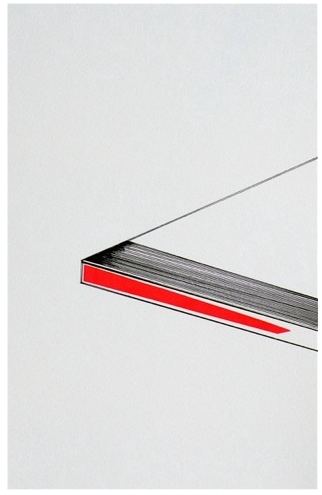 To March 27 at Lawrimore Project.
To March 27 at Lawrimore Project.
Ryan Henry Ward – whimsy hits the wall
Previous, much commented upon, post: Ryan Henry Ward gives Seattle a bad case of the cutes.
What made this post so objectionable to many appears to be my distaste for whimsy. Who could be against whimsy? I must be a monster. Possibly I needed more context. I associate the word, which comes from whim, with the kind of art that’s deliberately impersonating the drawings of children. It’s a step backwards to achieve an innocence not possible for adults.
No matter how technically inept, drawings from real children have a purity and grace. Fake children can no longer inhabit that experience. They can’t be what they once were, with chubby little fingers holding their crayons.
Certain folk artists draw in a style associated with childhood, but there’s a crucial difference in delivery. They’re serious. They have whittled away at their form, battered it down to a primal event instead of borrowing it from the five-year-olds in their lives.
For me, Ward is a prime offender in the we-won’t-grow-up art whimsy movement. His calcified cute clogs arteries. Even so, I don’t mind that he has a mural or two around Seattle. Had he done a few, I wouldn’t have said a word. But he’s big into volume, volume, volume. Fifty murals, 70 murals: He keeps changing the number. In a recent email, he said (contradicting an earlier one), that he has completed 48 public murals in Seattle and plans to do more.
What makes him think he’s entitled to that much public space? The business people who pay him don’t own the city. Everyone who lives here does. There are street artists/muralists I love, but I wouldn’t presume to suggest any one of them blanket Seattle with his wares. In public art, diversity is essential. There’s room for Ward, but not as much room as he insists on taking.
One more phrase to consider: ad hominem, or arguing through personal attack. You sweetness and light people appear to have hair-trigger tempers. A sizable number of you quickly devolve into playground name calling. No wonder you like artists who impersonate children.
Jim Melchert – the broken world
From The Crying Game:
Do you want to pick up your teeth with broken fingers?
Jim Melchert, Flip, graphite on broken porcelain, via Moon River
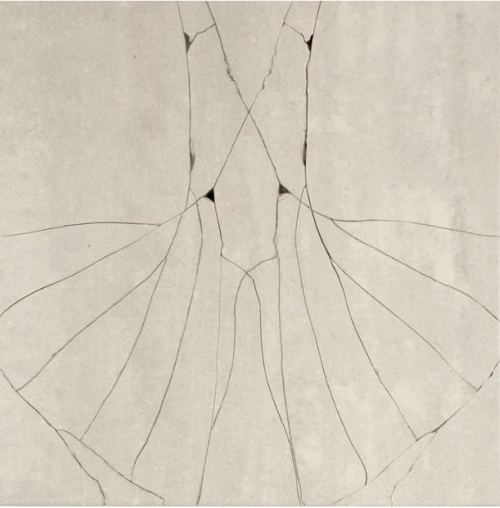
From Art Chantry’s vast collection of crap
Art (put-down-your-mice) Chantry has many objects he has chosen to accompany him through his life on earth. Some of them he’s showing off on facebook.
First up is a 78 rpm of Elvis Presley’s “Blue Moon”. Back in the early 1950’s , when 45 rpm records were first entering the market, those little 7″ plastic disks with the big holes were way cool. You wanted to impress your pals with your latest technology (sorta like the i-pad, ya know?) This person decided to crudely grind out the center of the 78 rpm (10″) record and then pop in a 45 adapter. That way he could actually fool his pals into thinking he was hip to the latest tech savvy universe!
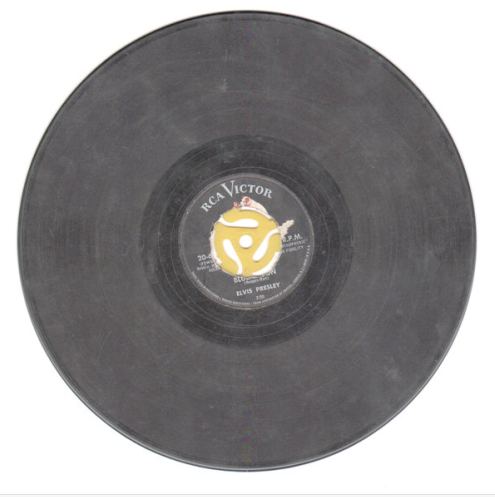
Hefty Dale Chihuly grant
The new Dale Chihuly grant is a hefty chunk of change: $25,000 for two Washington State artists in any discipline annually for three years, administered by Artist Trust. Chihuly and his wife Leslie gave $150,000, and Artist Trust turned it into a recession gap-grant with bells on.
Three years from now, we’ll all be coming up roses, right? Better a sizable check in tight times than the same amount extended over a longer period. I’ll drink to that.
The Chihulys could have limited the award to glass artists. I’m glad they didn’t. They could have limited it to visual artists. I wish they had, not because I begrudge dancers, writers, musicians and theater workers their chance at temporary financial security, but because artists in all disciplines benefit from what visual artists continue to provide, every year, at the Artist Trust Auction. That’s 23 years of giving away their work to support everybody’s work.
This year’s auction was a big success, says Artist Trust. It raised $325,000, $315,000, highest in AT history. The money earned by visual artists goes to fund “grants, resources and career training for artists in all disciplines throughout Washington State.”
The highest bid of the night was $5,000 for Alan Fulle‘s Freedom Space (23″ x 52″ oil and acrylic on canvas within epoxy resin from 2008). At the Traver Gallery, this piece lists at $7,500. The high-water bid was a bargain.
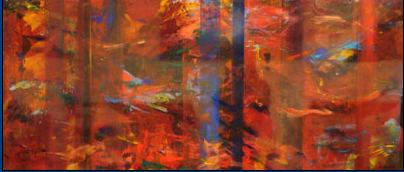 Fulle is underrated, but apparently not by those drinking champagne and waving bid paddles over their heads. Although he’s a dazzling and materially adventurous painter, he shows at a gallery known for glass. Its audience is a gated community, with little follow-through traffic on the street.
Fulle is underrated, but apparently not by those drinking champagne and waving bid paddles over their heads. Although he’s a dazzling and materially adventurous painter, he shows at a gallery known for glass. Its audience is a gated community, with little follow-through traffic on the street.
At any rate, congratulations to Artist Trust, and big thanks to the Chihulys.
Marsha Burns – New York, continued
Updating Robert Mapplethorpe…
With a banana.
Mapplethorpe image here. The update, by David B. Smith, below. (The Velvet Polyester, 2008)
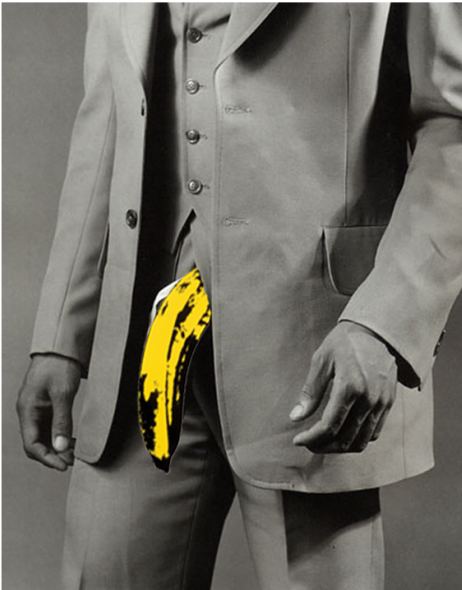
Militant illustrators (power to pencil pushers)
They are illustrators. Hear them roar in numbers too big to ignore.
Illustrator militancy is relatively new. Formerly, the breed took its second-class status for granted. If illustrators were discussed, they were the ones talking. In the art context, nobody gave them much thought. Illustrators were around (some good, some clever, most bland or annoying), illustrating things – advertisements, company announcements, greeting cards, t-shirts, comic strips.
Cartoonists proved the most unruly. Between R. Crumb and Art Spiegelman, they battered the opposition into a puddle, becoming a rising tide carrying all (drawings of) boats.
The question now is not whether it’s illustration or art. It’s what kind of illustration it is, and what kind of art.
Friends of the Nib at Vermillion Gallery features the drawings and prints of 31 Seattle illustrators (mostly cartoonists) who meet weekly “to chew the fat and scratch the
paper. “
As a group, they’re a wonder.
Take David Lasky: His ultimate graphic novel is one page, six panels. Lasky draws as if his pen swallowed a ball. All of his lines have bounce. What’s really distinctive is his writing. He channels Kafka by way of Donald Barthelme – pared to the bone, funny with a low-grade fever of the tragic.
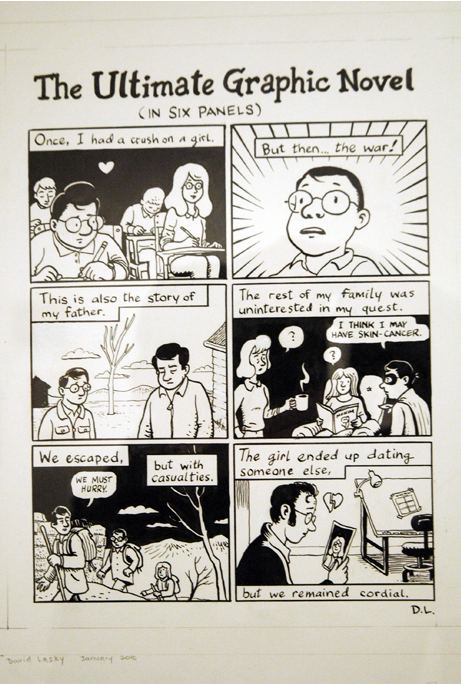 Then there’s Kaia Chessen, busting out of the frame but with a feeling of heirloom.
Then there’s Kaia Chessen, busting out of the frame but with a feeling of heirloom.
 Nobody puts Ellen in the corner. For big, clean and sexually charged graphics, she can’t be beat.
Nobody puts Ellen in the corner. For big, clean and sexually charged graphics, she can’t be beat.
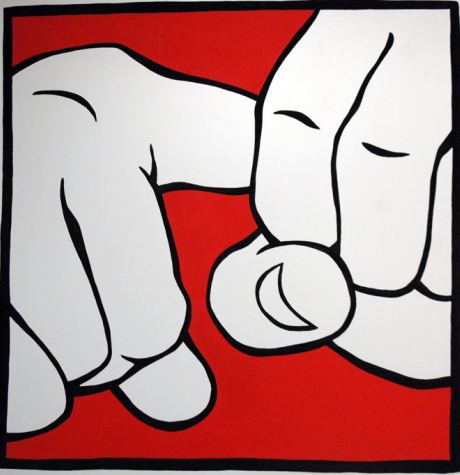 Through March 4.
Through March 4.
Paul Berger – a wide and placid view
How do animals see? Depends on whether they’re predators with eyes front and center, or prey, with eyes on the sides of their heads for an inclusive span.
Paul Berger became interested in the visual world of prey animals after reading Temple Grandin, who redesigns slaughterhouses to take away the terror. According to Grandin, prey animals do not feel anxiety or regret, but they have a fast trigger on fear. When nothing is wrong, they are calm as Buddha, even when seconds from their death.
McDonald’s hired her not because the company is swell in every way but because calm animals die more quickly, more cleanly. Also, with her on the payroll, McDonald’s has something to say in its own defense when criticized by animal rights groups.
Back to Berger and his wide span. (PANORAMAS SERIES, 2008-2010) He offers something rare those whose vision is selective in its focus. In his photos, the world shifts, becomes elastic and enlarged beyond the frame with which we were born, the narrow frame that helps us zero in for the kill.

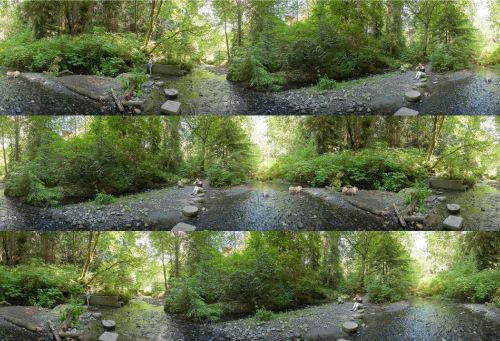
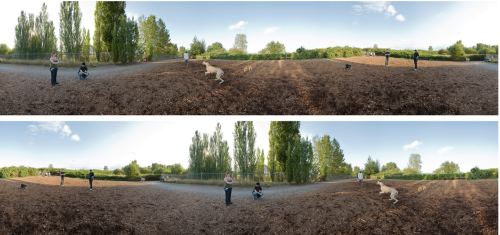
 Berger:
Berger:
I have been exploring extended synthetic
panoramic imaging, wandering into a kind of “bovine vision” of visual
horizon grazing between 240 and 360 degrees. It is the camera vision of
choice for those who scan the horizon wide, eschewing the specificity
of the pointed gaze for the more generalized awareness of a uniformly
focused peripheral vision.Technically, this series, as has been
the case with most “straight” photography in the past, at first appears
to be a seamless, straightforward transcription of the three
dimensional world. However, they are, in fact, the result of a highly
processed data stream. This stream begins with a sequence of seven to
ten wide-angle (24mm) individual photographs, taken with a digital
camera attached to a tripod on a head that allows for rotation about the
“nodal” point of the lens. The resulting images are merged, in
software, into either a cylindrical or spherical digital space. After
adjustments, a two-dimensional frame is imposed within this space (the
final “photograph”) and the result is exported back into a conventional
digital file.
Responding to my question about his (to me) invisible career, Berger replied with unruffled patience:
I have been published in Light and Lens, Photography in the Digital Age, by Robert Hirsh, 2007; Nash Editions: Photography and the Art of Digital Printing, ed. Garrett White, 2007; Photography, 8th Edition; London & Upton, 2004, Criticizing Photographs, An Introduction to Understanding Images, Terry Barrett, 2002; and Seizing the Light: A History of Photography; Robert Hirsh, 2000.
Also, photographs from the Panorama series will be published in the spring as part of The Digital Eye by Sylvia Wolf. For someone who is well known in Seattle because he is on the art faculty at the University of Washington, his work is rarely discussed. His 2003 retrospective at Chicago’s Museum of Contemporary Photography traveled, but not to Seattle. (Artforum review of that show here.) There is more than one way to have a career.



